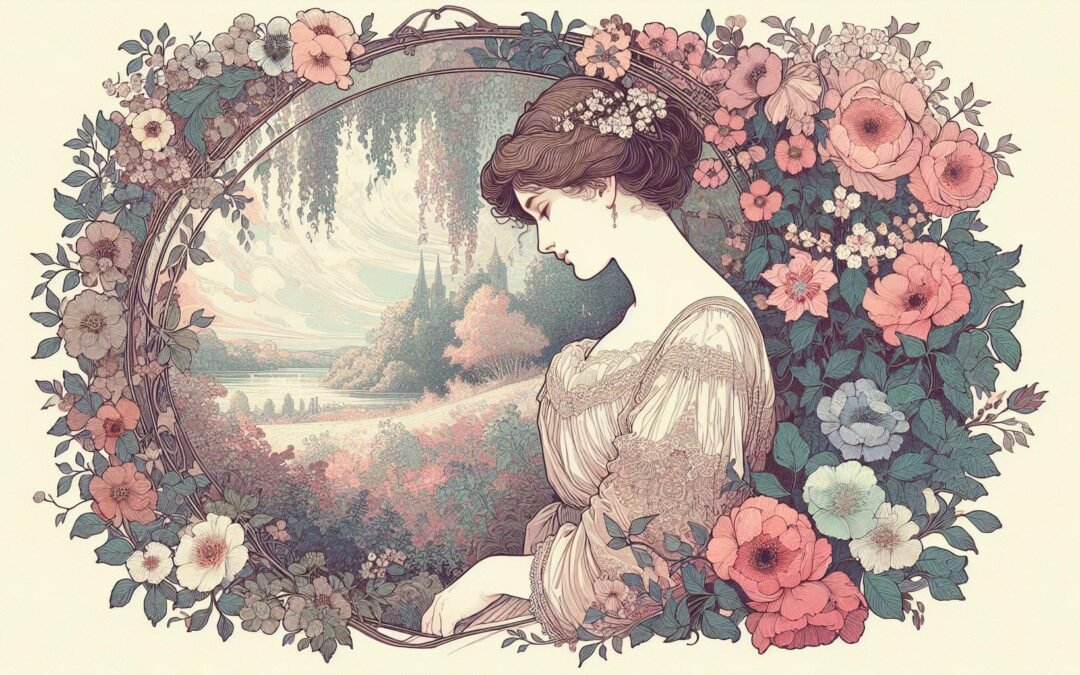Romantic poems for a beautiful woman have shaped the contours of love literature across centuries, summoning obsession, longing, and wonder in a language that courts both devotion and myth. Coded through metaphor, ritualized in poetic form, the celebration and interrogation of feminine grace spans a vast cultural and stylistic inheritance, spiraling through Sappho’s ancient fragments, Petrarch’s spiritualized yearning, the earthy magnetism of Shakespeare’s “Dark Lady,” and the audacious new voices of today. Explorers of this tradition journey not only through dazzling lyric but also through shifting ideas about gender, agency, and the ethics of admiration. Unveiling the radiant complexity of this theme, the poetries that nourish it remain a cradle for love’s possibility and a crucible for transformation. Encountering romantic poems, one finds not bland repetition but a mosaic of sensual, philosophical, and sometimes subversive gestures, ever renewing what it means to praise beauty.
Historical Trajectories of Romantic Poems for a Beautiful Woman
From the courtly civilizations of medieval Provence to the digital platforms of our era, the poetic celebration of women’s allure has mirrored both continuity and rupture in the history of literature. Ancient Greek lyric offers an early architecture: Sappho’s address to the female beloved, charged with the brilliance of Aphrodite, endures through the centuries, even as classic Latin poets like Catullus and Virgil positioned feminine beauty as portal to transcendence or madness. The rise of the troubadour poets entwined chivalric devotion with ritual: a lady became the axis of her lover’s creative striving, lawgiver of unattainable delight, and inspiration for new forms of lyric invention. These traditions shaped European approaches to love poetry, their residues evident in contemporary explorations.
Renaissance, Romantic, and Modern Evolutions
The Renaissance sonneteers refined courtly conventions, weaving Petrarchan paradox with Neoplatonic ideals to illuminate the beloved as muse and mirror for philosophical yearning. Figures like Laura inspired an entire lexicon whose traces linger in romantic poems and whose violations—Shakespeare’s subversive “Dark Lady,” for example—set new terms for passion’s ambiguity. The Romantic movement, encompassing talents from Keats to Wordsworth, plunged admiration inward, sometimes fragmenting the beloved as a force of psychic transformation, other times reclaiming tangible, embodied beauty and the textures of nature. In the Victorian period, poets like Elizabeth Barrett Browning rescued the tradition for women’s voices, setting the stage for future generations to speak desire and vulnerability from within.
Changing Attitudes Toward Love and Gender
The adulation of feminine beauty in poetry has never been static. Early lyricists usually sculpted the beloved as remote, abstracted, an emblem for spiritual striving but rarely a speaker. Over time, Enlightenment influences invited more reciprocal and dialogic forms of address, unraveling property-like metaphors. By the nineteenth and twentieth centuries, women poets began forging space for self-determination and creative reciprocity, not only receiving praise but articulating what it means to be seen, to love, and to resist abstract idealization. This evolution resonates boldly in many best contemporary poets whose fresh visions now redefine the possible shapes of devotion and personhood.
Themes and Motifs in Romantic Poems for a Beautiful Woman
Poetry honoring feminine beauty revolves through recurring yet ever-changing arcs of inspiration, longing, reverence, and self-discovery. At the center lies the enigmatic question of beauty’s nature and its power to remake the speaker and the world.
The Alchemy of Beauty and Literary Transformation
Beauty evokes paradox. Physical features (eyes imagined as starfields, lips bright as sunrise) do more than delight. They incite language into fervent invention, setting the beloved amid a cosmos of symbols. Spiritual beauty elevates this further, transforming praise into a meditation on the soul’s hunger or on the mystery of presence and absence. Through fine-grained metaphor, the beloved exists within the weather of the world: a rose, a flame, a storm’s fleeting gold. This dynamic is visible in the Petrarchan sonnet form, where each effort to name perfection only renders its distance sharper. Readers experiencing rhyming love poems discover this same energy translating through rhyme and pulse, proof of love’s insistence on the musical and the ineffable together.
Longing and the Poetics of Absence
Yearning animates the tradition of romantic poems for a beautiful woman, creating a geography of hope and heartbreak. Whether in Dante’s reverence for Beatrice or Yeats’s devotion to Maud Gonne, poets circle what cannot be possessed. The beloved stands at the horizon of desire, both the source of language and its unreachable goal. This interplay animates the lyric’s capacity to both reveal and conceal: longing attaches itself to beauty, shadowing every utterance with the ache of separation. Cycles of approach and retreat forge poems into chambers of memory, confession, and anticipation, as documented in most romantic poems of all time.
Nature and Metaphor as Bridges
Poets employ the natural world to refract and amplify feminine beauty. Storms, gardens, skies, rivers serve as both setting and simile, recasting the beloved’s allure as elemental force. The body becomes a constellation. Her voice is a melody shaped by rain; her glance, a sunlift after darkness. These figures are not decorative but vital, allowing the poet’s emotion to find tangible shape. For insight into the mechanics and meaning of literary metaphor, see metaphors in poetry, which traces how these tropes transform perception and reinvent what adoration can be.
Admiration Versus Objectification
Every act of poetic praise exposes a fragile balance between genuine celebration and turning a real person into symbol or fantasy. Some verses suspend the beloved in timeless perfection, emphasizing static beauty while muting agency. Others strive to illuminate motion, intelligence, or mutual presence, especially in the innovative works of women poets. Modern and feminist interventions frequently complicate inherited tropes, pushing poetic language toward collaboration instead of possession. Contemporary poetry’s engagement with this tension is explored in works where adoration becomes a kind of dialogue, shaping not only how women are seen but how the speaker’s self emerges.
Key Poets and Canonical Works
Exemplars of the romantic tradition reveal the myriad faces of the beautiful woman: messenger, muse, antagonist, memory, self. The tradition’s richness springs from its diversity as well as the deep shadows that questioning brings.
Petrarch’s Devotion to Laura
Petrarch’s sonnets to Laura, housed in the landmark Canzoniere, fixate on the beloved’s golden hair, modesty, and exalted distance, generating a template for desire’s eternal pursuit. Laura becomes at once human and supernal, a generative force who awakens the poet’s creativity and spiritual yearning. Through oxymoron, paradox, and hyperbole, Petrarch’s verse oscillates between ecstasy and despair, making Laura an innovation in the architecture of love poetry. For readers seeking an entry-point to this tradition, types of love poetry sheds light on the structure and impact of the sonnet in immortalizing longing.
Shakespeare and the “Dark Lady” Sequence
Shakespeare’s “Dark Lady” sonnets renounce gilded archetypes, instead conjuring beauty as mutable, earthy, and enigmatic. The beloved here is a presence with her own gravity and wit, a woman who resists simple praise and instead excites paradox, contradiction, and desire’s volatility. The poetry acknowledges the physical and emotional ambiguity of attraction, fusing lyrical complexity with sharp, unsentimental honesty. Shakespeare’s innovation lies in how beauty becomes a field for contest, play, and artful provocation. The best love poetry books illuminate his persistent influence.
John Keats and the Bewitching Other
Keats’s “La Belle Dame sans Merci” reimagines the motif of feminine beauty as both charm and omen. The poem stages fascination as an encounter with mystery: the woman who entrances, nurtures, and abandons, leaving the knight in a trance of loss. Her allure operates with both tenderness and danger. Keats fuses sensuality with symbolism, raising questions about how beauty seduces and wounds. His approach, mirrored in selections within best John Keats poems, embodies the Romantic tension between creative ecstasy and the shattering of certainty.
Elizabeth Barrett Browning and Love’s Confession
Elizabeth Barrett Browning’s “Sonnets from the Portuguese” mark a revolutionary act of self-revelation. Here, the woman writes as both lover and beloved, bringing lyric intensity to the landscape of mutuality, vulnerability, and erotic awe. Her sonnets reject ornamental idealization, sharpening the gaze upon the beloved’s inner world and the shared trembling of genuine encounter. Instead of an object, the beautiful woman becomes a subject who sees and is seen, desires and is desired. These innovations pulse through later women poems, echoing Barrett Browning’s vision of reciprocity.
Contemporary Voices, Global Horizons
Poets of the last century—Adrienne Rich, Rita Dove, Warsan Shire, Yosano Akiko—reshape the language of beauty through intersectional, global, and queer perspectives. Today’s poetry explores flux and plurality, refusing any single vision of what the beautiful woman means or inspires. Spoken word, social media, and hybrid genres drive this flowering further, producing new, boundary-crossing modes of devotion and critique.
Imagery, Form, and Technique in Romantic Poems
The technical makeup of romantic poetry for a beautiful woman is as vital as its themes. Imagery, form, and sensuous language orchestrate the music of longing and praise, forging unforgettable textures.
Imagery, Symbol, and Sensation
Iconic romantic verse overflows with images of skin luminous as marble, eyes reflective as night rivers, voices that ripple through air or memory. Symbols cluster in patterns—mirror, flame, rose, garden—drawing on myth and archetype to expand a single glance or gesture into a field of emotionally charged associations. Sensuous detail—the warmth of breath, the taste of honeysuckle, the shimmer of laughter—saturates the world of the poem. Literary analysis in imagery in poetry unfolds how such details awaken readerly desire and render beauty palpable.
Sonnets, Odes, and the Lyric Mode
Form embodies feeling. The sonnet structure asserts argument and pivot, maintaining tension and release within the bounds of articulated beauty. Odes grant expansion, tracing admiration through spacious, meditative stanzas that chart transformation over time. Lyric poetry compresses emotion, melody, and rhythm in compositions that echo the heart’s own urgency and suspension. To practice or appreciate these forms, consult guides on how to write love poetry, which reveal the craft beneath the passion.
Modern Inventions and Future Horizons
Contemporary poetry expands beyond inherited limits, borrowing from diverse cultures, innovating hybrid structures, and experimenting with voice. Spoken word, free verse, and digital poetics diversify how beauty, longing, and identity interact. In these evolving landscapes, the tradition of the romantic poem for a beautiful woman persists as an abundant wellspring, inviting perpetual reinterpretation and genuine encounter.

